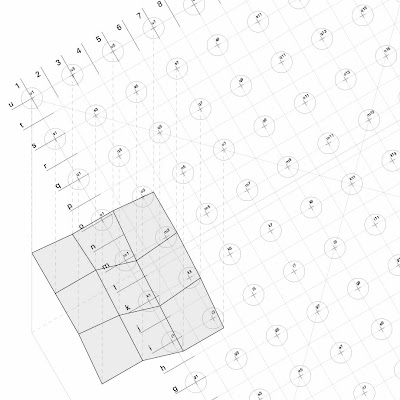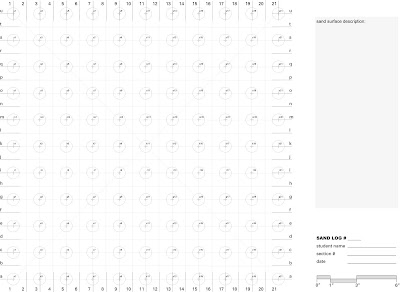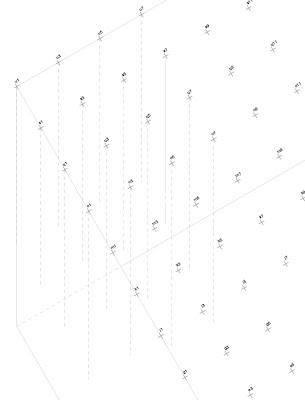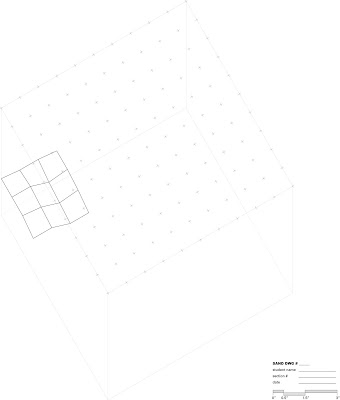 clickable image
clickable imageTo log & construct a plan oblique graphical representation of the surface of your sandbox using only lines.
Procedure:
1) Download & print the pdf file "1412_Sp08_XXX_SandBox_100ptLog.pdf" on 11 by 17 paper in landscape format & "fit to print". The outcome should look close to this:
 clickable image
clickable image2) First write a description of the surface(s) in your sandbox in superficial & formal terms in the given space on the printed out log sheet. Use the terms we've started talking about in everyday geometries. Describe hierarchies, alignments, & other relationships / differences in surface quality.
3) In your sandbox measure the height of the 100 pts indicated on the given graph & log each of them in pencil in the corresponding circle on your printed out log sheet. Keep this paper log. Pin it up over your box. It will be a part of your grade.
3) In your sandbox measure the height of the 100 pts indicated on the given graph & log each of them in pencil in the corresponding circle on your printed out log sheet. Keep this paper log. Pin it up over your box. It will be a part of your grade.
4) We recommend you use Illustrator for this assignment if you have it but you can do the work in a CAD application too. These instructions will try to remain "neutral" but the CAD files may have some distortions and layer changes in them. All work was done in Illustrator.
For CAD: Download & open the DWG file "1412_Sp08_XXX_Sandbox_100ptWork.dwg".
For Illustrator: Download & open the AI file "1412_Sp08_XXX_Sandbox_100ptWork.ai".
5) With the file open get familiar with all the layers, lineweights, & linetypes. You will draw in the work layers. The layers have been arranged so that the top three are your work, the next few are the most needed references, & the last few layers are more obscure and non-print references. Here is an image of what layers are in the file in Illustrator. (If your CAD file has messed up layers you should move things to match this set-up.):
6) Turn on the work layer "Depth Lines". On that layer we've started an example for you to review. Once familiar with the method you should erase this sample. From each grid intersection draw a fine, grayed short dashed line down from the point as long as the sand is deep in the box. Here's the way this should look:

7) Turn on the work layer "WorkLayer-ProfileLines_North to South". On that layer we've started an example for you to review. Once familiar with the method you should erase this sample. Along each "east-west" row of depth lines connect the bottom end points of each line with a medium, solid , & black line segment. Here's the way this should look:
 7) Turn on the work layer "WorkLayer-ProfileLines_North to South". On that layer we've started an example for you to review. Once familiar with the method you should erase this sample. Along each "north-south" row of depth lines connect the bottom end points of each line with a medium, solid , & black line segment. Here's the way this should look:
7) Turn on the work layer "WorkLayer-ProfileLines_North to South". On that layer we've started an example for you to review. Once familiar with the method you should erase this sample. Along each "north-south" row of depth lines connect the bottom end points of each line with a medium, solid , & black line segment. Here's the way this should look:
8) You're done drawing! Turn on all the work layers to see it this way:
 9) Now turn off the depth lines & the notation so that you have the box, the sand surface, the top level intersections, & the title block. It will look like this:
9) Now turn off the depth lines & the notation so that you have the box, the sand surface, the top level intersections, & the title block. It will look like this: 10) Print it full scale on the OCE, or one of the large format printers in the print bureau. Pin this drawing up over your sandbox. Your TA can help you with printing during class.
10) Print it full scale on the OCE, or one of the large format printers in the print bureau. Pin this drawing up over your sandbox. Your TA can help you with printing during class.11) Save the file as a pdf file named "1412_Sp08_XXX_Sandbox_100ptWork.pdf". Your TA will show you how to do this in class on Tuesday.
This is due by the end of class on Tuesday. You will be marked for completion.



